It’s been another busy week and here are some of the key things that have captured my attention.
Access for Everyone approved
Yesterday the Council voted to approve the updated City Centre Masterplan which is fantastic news.
Auckland’s innovative vision for its city centre – a more liveable, green and people friendly future – is here with today’s adoption of a refreshed City Centre Masterplan.
Auckland Council’s Planning Committee has agreed the high level 20-year vision for the city centre and waterfront off the back of an overwhelming 76 per cent support through public consultation.
We’ll talk more about this news in a separate post but one thing I did want to call out here was a line in an article from Bernard Orsman which picks up some of the analysis done by Auckland Transport as part of their response to the CCMP.
AT pointed out that despite all the investment and more attractive transport options since 2001, the number of people travelling by cars to and from the city in peak periods has remained fairly constant at about 40,000. The growth in travel has been accommodated by extra trips on public transport, walking and cycling.
It comes from this graph in an AT note to the council.
Firstly, the way the data was captured in 2001 and how it is captured now, with as I understand it has changed and is not entirely consistent. As I understand it, previously it was done by people manually counting on the side of the road on a single day whereas today it is captured automatically and by the minute from embedded intersection counters.
We now have over five years of that automated data and it is released monthly. When converted into a 12-month rolling total it shows a clear trend. It shows that the number arriving by car has dropped from 42k to 35k over that time – and it was about 38k in 2018 which is the data Orsman’s article is based off. That data is also backed up by the trends we’ve seen in motorway access which I wrote about last year.
What I think this shows is just how quickly the city is changing and why it’s important we keep pushing for better outcomes.
ADO restructure
The refreshed CCMP has come from the Council’s Auckland Design Office (ADO), the team also responsible for changes such as those on High St, the shared spaces and many other positive changes around the city. Yet just a day before the council decided on the CCMP, it was revealed the team were being disbanded
The council design team tasked with making Auckland’s downtown and suburban centres more people friendly, is to be broken up in a planned cost-cutting move.
Eight staff may lose their jobs and others may be shifted to different departments.
The proposed disbanding of the Auckland Design Office (ADO) has been called “cost-accounting at its worst” by planning committee chairman, councillor Chris Darby.
I think this is an appalling decision from the council. The ADO have proven themselves to be visionary, innovative, efficient, effective and passionate about improving our city, perhaps more so than any other team in the council family – all the things we should want from council staff. In my opinion, axing them is about sending a clear message to the rest of the council not to rock the boat and challenge the status quo or you’ll be out of a job.
The language council are using to justify this, that they’ll be embedding the teams within council, is eerily similar to that used by Auckland Transport a few years ago to disband their dedicated walking and cycling team. That set cycling projects back by years and what little we’re now seeing is of substandard design. It seems that every restructure in the past few years in Auckland Council, AT or NZTA has turned out to be a disaster that undermines delivery of the strategies those very organisations have developed.
Road Deaths in Feb
After a better start to the year in January with many fewer road deaths than recent years, that work was undone in February following the highest number of deaths in the month in over a decade. In total 34 people sadly lost their lives – and the numbers were up even before you count it being a leap year.
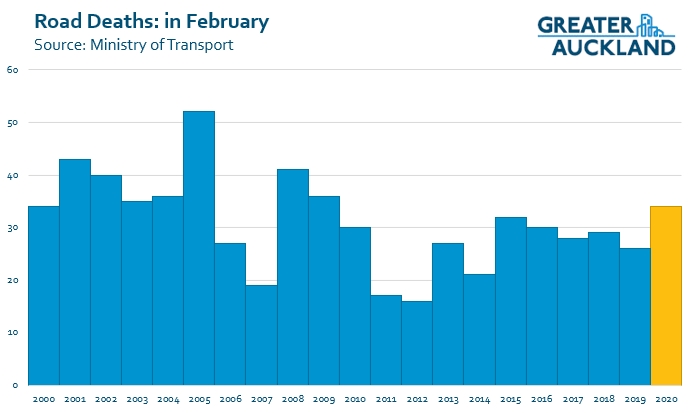 This means we’re still tracking at about 350 road deaths annually which is about 100 more than the lowest point we achieved back at the end of 2013.
This means we’re still tracking at about 350 road deaths annually which is about 100 more than the lowest point we achieved back at the end of 2013.
AT Safety projects
Auckland Transport announced a number of safety projects this week.
Dairy Flat Highway
AT will be installing median wire rope barriers on part of Dairy Flat Highway
Auckland Transport (AT) is continuing its roll out of safety improvements on Dairy Flat Highway – one of the most dangerous rural roads in Auckland.
The installation of a median wire rope barrier at the current southbound passing lanes between Durey Road and Potter Road begins next month.
The former state highway has had a number of fatalities and serious crashes. Between 2008 and 2017 there were 9 deaths and 55 serious injuries. The southbound passing lanes have been the location of several serious and 1 fatal head on collision over the past 5 years.
…..
The safety project is complemented by a new right-turning bay at the intersection of Potter Road and Dairy Flat Highway.
Works at Potter Road will start after completion of the median barrier.
AT’s group manager of network management Randhir Karma says the entire scheme will cost approximately $622,000 and has been strongly supported by the Rodney Local Board.
Mt Roskill
Construction will start next week on improving safety around schools in Mt Roskill.
Walking or cycling to school in Mount Roskill will now be safer, thanks to Auckland Transport’s Safer Communities programme.
80 per cent of all road deaths and serious injuries occur on 50km/h local urban roads.
Nearly half of those deaths and serious injuries involve vulnerable road users – children, elderly, people walking and people on bikes or motorcycles.
Mount Roskill is the first community to benefit under the programme, with Mangere Bridge and Papakura to follow.
Safety improvements will see wider footpaths – with clearer boundaries between them and properties. There will also be raised pedestrian crossings and raised speed tables to encourage safer speeds.
Manurewa speed calming
AT have started work on what they say is the largest area-wide speed calming project
Auckland Transport (AT) has begun road safety improvements on residential streets in Manurewa to provide a safer environment for all road users.
The residential speed management project – covering Browns Road, Roscommon Road, Russell Road and Weymouth Road – was partly funded by the Regional Fuel Tax, along with the Manurewa Local Board.
The $4 million dollar project aims to reduce vehicle speeds with a combination of speed-calming measures – including 11 raised zebra crossings, 10 Swedish style tables, 117 speed humps and 23 red-coloured entry treatments.
Gt North and New North Road Ped Crossing traffic lights
AT yesterday started consultation on plans to install two sets of traffic light controlled pedestrian crossings. Both consultations are open till 25 March.
- The first is on Gt North Rd about 150m north of the intersection with Blockhouse Bay Rd
- The second is on New North Rd next to the western pedestrian underpass access to Morningside Station
Wellesley St Closure
Works have now started to build the Aotea Station as part of the City Rail Link and it has involved closing the Albert/Wellesley St intersection, which they’ve time lapsed
I’m looking forward to more time-lapse videos over the coming years.
Of course for people walking, not having to wait to cross the road has been a benefit
https://twitter.com/miriammooretoo/status/1234565297413058560?s=19
More Wrapped Trains
The artistically wrapped train which was to promote rail safety was a great initiative Auckland Transport and even though it’s exactly the same inside as every other train is always exciting when it turns up on a service you want to catch.

And now Auckland Transport want to do three more
Are you an Auckland based artist or designer? We want you! We're looking to wrap more of our electric trains. You'll have a 72 metre blank canvas to design something uniquely Auckland, while also incorporating a message of rail safety. Find out more: https://t.co/1VoMgUFhUK pic.twitter.com/5TOnmvb2jp
— Auckland Transport (@AklTransport) March 4, 2020
Hibiscus Coast Bus users
If you catch the bus to the Hibiscus Coast and you’ve had problems with full buses, as described in this article, perhaps one solution for you is to catch the first bus to Albany and switch there. I appreciate it’s perhaps not as convenient as a one seat ride like you may prefer but it might get you home faster and doesn’t cost anything extra if you’ve used your HOP card.
The Climate Debate in Auckland
A good interview with Councillor Richard Hills about how we respond to climate change, including these quotes
“We should be trebling the rate of building cycle lanes – 10 kilometres a year is not good enough, it should be 30.
“If you give people options – which I don’t think we are – people will change.”
…..
“Theoretically we need to increase our public patronage by about 300 per cent in the next ten years, which is not small,” he said.
The roll-out of electric buses, and maybe even electric ferries were just part of that mix, along with boosting cycling and walking, he said.
Freddy the Fork
The new extension to the NW Cycleway from Lincoln Rd to Westgate is largely great with the major exception of getting through the Lincoln and Royal Rd interchanges. Reader Murray spotted this great note at the Lincoln Rd crossing.
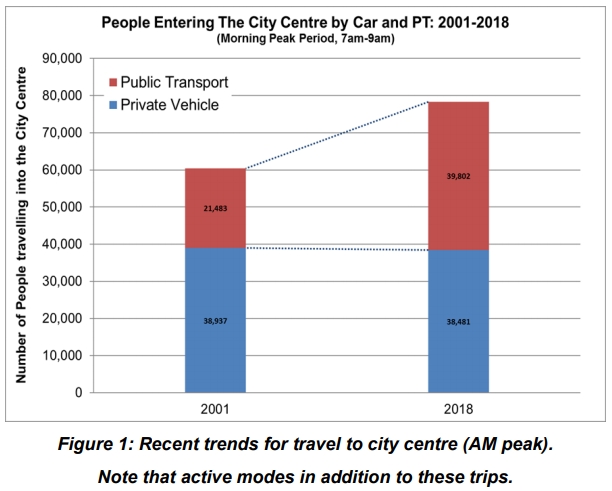
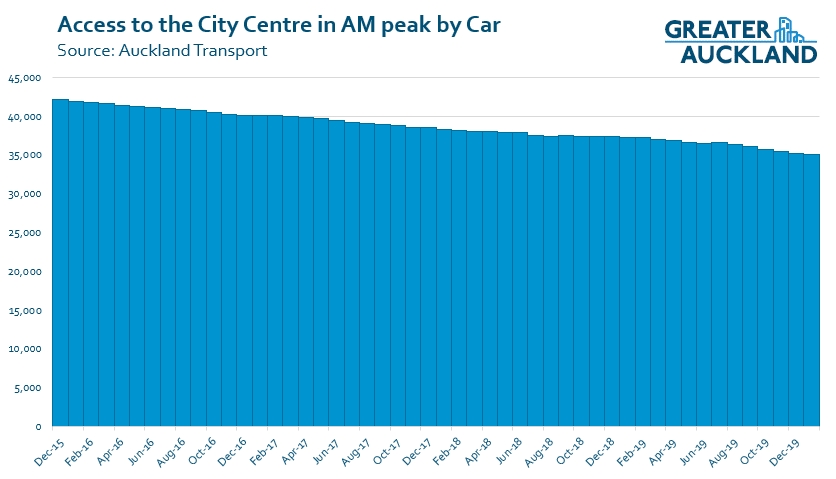

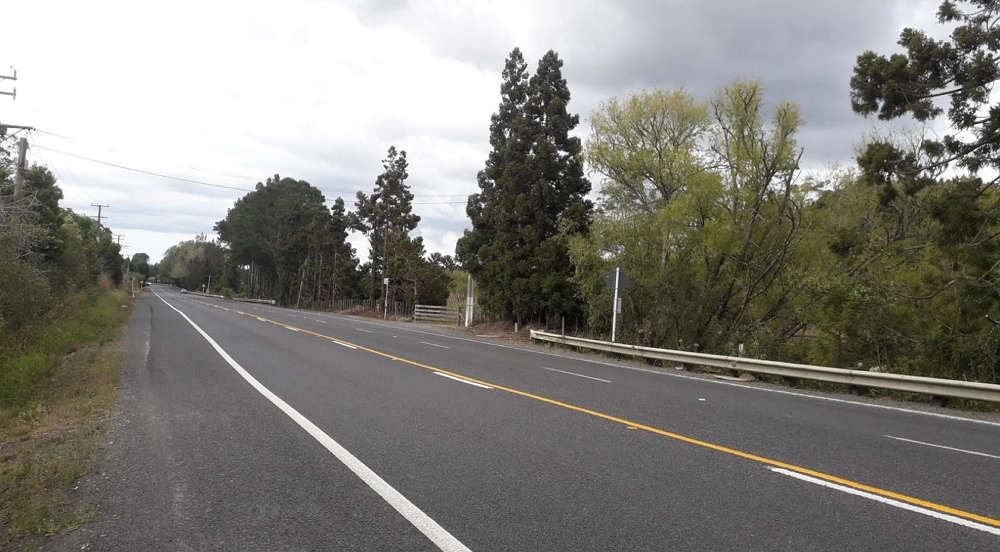
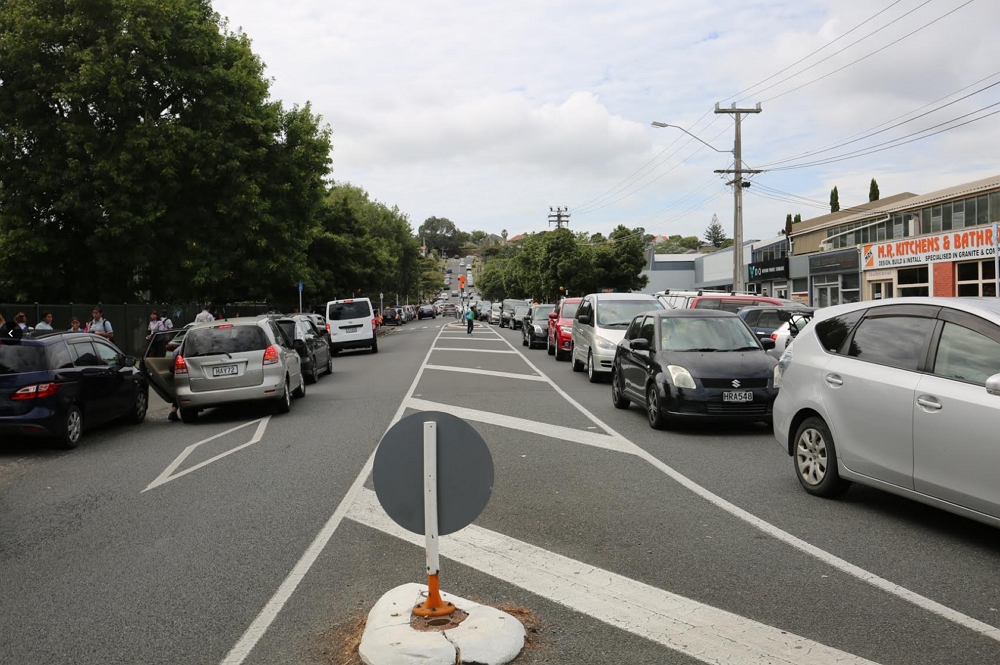

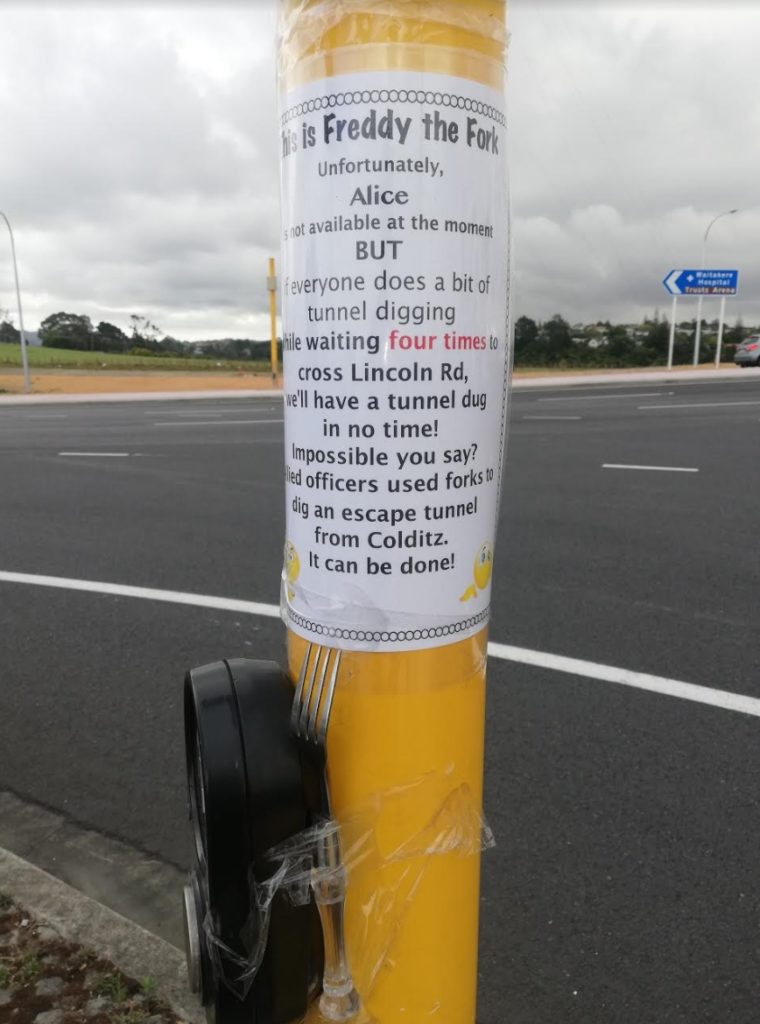

 Processing...
Processing...
Matt
I like how you have highlighted the drop in vehicle numbers entering the city. There has been many posters to this blog expressing a view that if you take one car off the road somehow there will be another car to take its place. Overseas evidence shows that this simply isn’t true and that car mode share can be reduced by taking cars off the road.
Surely now is the time for all parts of AT to work together to achieve that aim? Sure it is great that bus and train networks have been much improved, but where is the reduction in parking, increased bus and bike lanes with a view to increasing emissions?
“There has been many posters to this blog expressing a view that if you take one car off the road somehow there will be another car to take its place”
Yes, I agree that that is one of many oft-repeated nonsenses with no basis.
there’s considerable research that looks at the vehicle demand response to road capacity expansions. Most land on an elasticity of about +1.0. Like as this paper, for example:
https://pubs.aeaweb.org/doi/pdfplus/10.1257/aer.101.6.2616
I think all things being equal, a car would take it’s place? Would this Auckland specific case be that it was pretty maxed out to start with and then some good alternative modes have been introduced or improved (electric trains, busway, NW cycleway etc) but importantly parking costs have increased generally & vehicle access somewhat squeezed in the central areas due to CRL etc works.
agree. I expand on similar points below.
Hi John,
I think your comment reveals a couple of confusions, which I can hopefully go some way to clearing up.
First, there is a large body of research that reaches clear findings on “induced vehicle demand”. That is, increases in road capacity lead to more vehicle travel, and vice versa: reductions in road capacity lead to less demand. Several studies also look at PT and find no effect on overall vehicle travel, such as this one:
https://pubs.aeaweb.org/doi/pdfplus/10.1257/aer.101.6.2616
The implication of this research is that where PT investment causes car drivers to shift to PT then much of the spare road capacity will be taken-up by new demand for car travel. The elasticities in that paper are around +1.00. While this will vary from place to place, it’s likely to range from 0.50-1.50. That is, at least half the additional road capacity freed up by road investment or mode shift is likely to be consumed by more driving.
Second, car mode share and vehicle travel are not the same thing. Consider a situation where 10 people travel to the city, 4 of whom drive and 6 of whom use PT. Now consider a PT improvement that causes 1 person to switch to PT, but also supports 1 extra job in the city centre. Let’s assume the new job is filled by someone who drives. That leaves us with 7 people using PT and 4 people driving. In this example, car mode share has declined whiled vehicle travel has remained the same.
In the case of Auckland’s city centre, there’s many potential explanations for the observed reduction in vehicles entering the city centre:
— reductions in local road capacity; and/or
— increases in parking costs.
Both of which would cause a permanent reduction in vehicle travel.
And keep in mind that many PT improvements, such as bus lanes, reduce road capacity and increase the costs of driving. Lower car demand in response to such outcomes is precisely what the evidence would suggest.
“Wrapped trains”? Come on AT – that’s just graffiti. Seriously, what is the difference between uncontrolled dicks tagging a train (and it being taken out of service to be cleaned at great cost) and having your trains “wrapped” in paint? I’m not impressed. Is anyone really likely to read the side of the train as it whizzes by? Either celebrate the fact your trains are clean and shiny and all silver; or save money and let them get covered with graffiti inside and out. Don’t muddy the waters.
I thought it looks pretty fugly myself. But horses for courses I suppose, I have a negative reaction to graffiti and “street art” in general.
Daniel has this train been tagged since it was done ? like the trains that haven’t been done .
Why would you ask me that?
I like them. I guess art is very subjective but I like to occasionally see something creative / gritty and different from the usual AT colours/style. Don’t get me wrong – I also admire that AT brand/style and think they do a much better job of creating a cohesive looking fleet than many other cities.
If they did all the trains then I agree it’d be boring – but only a few will be done, creates a bit of visual interest.
Daniel – I love seeing different graffiti and art on walls during the train ride. Tagging I’m not a fan of, but the bigger ‘bombing’ pieces are awesome, a lot of talent involved in those pieces.
A nice low-cost initiative to get heaps of free publicity about new trains, I dare say that would drive a few more bums on seats. May also appeal to a different demographic who want to see them or be seen on them.
That Freddy the Fork is gold!
Ways Both Look is an important message that needs to out there in the community.
LOL. I didnt notice it until you mentioned it.
I guess it depends which way the train is moving for it to work.
Perhaps it was written in the ablative rather than the accusative.
Far out hadn’t seen the words either, not I can’t not see them. Always wondered how it was meant to send the message specifically.
That’s because you have to “look both ways” to read it fully.
Master Yoda wrote ‘Ways both look you will’
The Hibiscus Coast problem is also a problem that occurs with the 27T/H/W buses coming out from the city. Everyone catches the 27H and 27W buses even though they get off at Mt Eden. It has left many people behind who actually want to go to Waikowhai etc. The solution is either
1) Make the 27H/W pick-up only from the city to Three Kings
2) Have everyone catch a 27 bus, which stops at Three Kings, those who need to continue on can catch a 27H/W, and make the 27H/W start at Three Kings, not at the city.
But if you are living in Hibiscus Coast… you’re not going to be getting into the city within 30 minutes.
If you’re waiting on a stop where a couple of lines overlap, and you’re not sure if your particular bus/train/tram will have room, you catch the first one that shows up, and if it is the wrong one you get off where they stop overlapping.
This is basic knowledge for regular PT users.
And Hibiscus Coast is not exactly close, but it is not that far either. Many other cities have regional level PT, so you can go from city centre to a regional centre 40km away in under an hour.
Sometimes though, people are just people.
When I worked in Fanshawe St. and caught the Birkenhead Bus Co service to Glenfield there were some which ran non-stop to Highbury shops and all stops thereafter.
Even though they were clearly signed on the front there were frequently passengers on board getting distraught that the bus ran all the way up Onewa Rd without stopping to let them off.
Sometimes the driver would relent and pull over to let them out but then that negated the whole point of having an express service.
Has anyone seen this press release from yesterday?
https://www.scoop.co.nz/stories/BU2003/S00094/rails-freight-value-merely-a-mirage.htm
Personally, I have no interest in hearing anything from Nick Leggett anymore. He sold his values out as soon as he gave up his Labour party membership.
He’s like a lot of these arseholes: When he got his hands on money, he became a tory.
With the drought and the virus a lot of supply chains are being disrupted. I have heard a lot of meat is being stored in containers around the country. I have noticed a lot of refrigerated containers moving on rail lately maybe its related. Its good to have a high capacity option to move freight and empty containers around when ships are diverted or cancelled.
Soon the road transport industry are likely to learn that a head in the sand approach to climate change won’t work, just as Federated Farmers seem to have. https://www.stuff.co.nz/environment/climate-news/119995342/federated-farmers-backs-plan-to-reduce-onfarm-emissions-by-2025
I suspect that Federated Farmers thought for quite some time that they could simply say, amongst other things, we don’t think we should pay an emissions charge, and we don’t think we should pay more for our polluting utes. There has been a significant response with many Kiwis saying, and we don’t have to and won’t buy your meat and milk.
Climate change issues are being decided in the court of public opinion and many businesses are learning that being on the wrong side is not helpful.
What I would like to see is a Govt. telling this industry that they will have to build their on highways/roads without any Govt/taxpayers help and tell them that those roads are for them only and they are not allowed any were near the existing build roads . And my guess within a year they will be crying to who-eve’rs in power they can’t/wont be able to maintain their new roads .
And the likes of Legget and his pals complain that KR needs a few dollars to help repair 4000 plus Km’s of their rail need their heads read . And KR have been doing it for years out of their own meager pocket for years as different powers that be just seem to want them to die .
“What I would like to see is a Govt. telling this industry that they will have to build their on highways/roads without any Govt/taxpayers help and tell them that those roads are for them only and they are not allowed any were near the existing build roads .”
I’d love to see that too. But we both know that’s not going to happen.
I’d like to see a government in the future, when presented with lobbying for some dopey & un-needed fancy new road (for example that ridiculous Granada to Petone link being pushed in Wellington) to simply say: “Oh yes we’ll allow a private company to build it as a tolled turnpike”.
Wouldn’t that be a great litmus test of whether the road’s a good investment and whether people really need it?
Yeah that’d be awesome. We could do the same with Dominion rd trams…..
Those wrapped trains don’t scream out rail safety to me at all. In fact they do the opposite… make the train look like it’s been tagged!
How much of our precious transport budget was spent on this? Design and wrapping doesn’t come cheap (and presumably that was a train out of service for at least a day – when we still have 3-car EMUs rolling around the network).
So money wasted that doesn’t even achieve its goal (safety)…
Please stop being cute and supporting this rubbish unless it’s actually done properly… like this: https://www.latimes.com/local/lanow/la-me-ln-rail-safety-month-20130903-story.html?_amp=true
“their dedicated Hibiscus Coast service”. Sorry what? It isn’t a dedicated service – It’s an NX1 that happens to go to SIlverdale.
I haven’t noticed an overcrowding problem on northbound peak NX1 for a while now. Sure it was chaos when they moved the stop at Britomart, but that seems to have calmed down now. The solution to their problem would be more NX1-HC buses, not limiting everybody else. If you limit everybody else you just move the problem to a different bus.
The ADO restructure demonstrates how dysfunctional our Auckland Council.
Any new ideas that challenges the status of quo will be viewed as a threat to the ’empire’ own by the existing senior bureaucrats. So progressive ideas and people must be eliminated.
Sounds very familiar to some of the autocratic dictatorship governments against progressive oppositions.
However we are a democracy country and our elected politicians need to favor public good instead of the selfish empire own by the senior bureaucrat’s self ego and benefits.
I think the politicians should leverage their power to shows the bureaucrats who is the owner.
In the old days they would have got jobs at a different Auckland Council. Now they are screwed.
Maybe the problem the type of people we allow to manage our public organisations. Or maybe the problem is within the professions.
The council officers are supposed to provide stability, offering best-practice evidence-based advice that is not subject to huge political swings. I imagine this is being prevented by two phenomena:
1/ The specialists are giving best-practice advice or would if they were in a supportive environment, but the management obstructs progress. Sometimes this is what we have. Conservative business-as-usual types rise through the organisations. They don’t get there with forward-thinking action, so they don’t value it.
2/ The specialists aren’t giving best-practice advice. In some areas, we have this problem. It seems incumbent industries and incumbent demographic groups have a hold on the professions. In turn, the professions are letting us down by not acknowledging their role in the situation and by not monitoring and enforcing their ethical standards.
Wellesley St Road Closure…
Such a good point that disruptions are really only looked at from the perspective of the driver.
If we look at it as ‘movement over mode’ then the downtown works disruptions are already a raging success without anything tangible being built. Less cars, better for pedestrians.
Well done AT! Keep up the good work. (absolutely no sarcasm intended). How do we message this better?
Yes looks a lot faster for pedestrians, it’s a great outcome.
I am amazed at the gaping disconnect between what Cr Hills is talking about and what AT is doing. Hills correctly identifies that Auckland will need PT ridership above 300 million per year by 2030, alongside other radical changes, and what is AT doing to change things? Right at the moment they are moving two intersection consultations at a time; and one 100m strip of city bike lane.
This is patently absurd and shows that the present method of consultation is woefully inadequate. As Heidi says there needs to be a move to something like the European SUMP process where the city is looked at in totality and Auckland is delivered an outcome where all the pieces fit together.
Yes it’s slow as at present & costs money. I do wonder if close local knowledge sometimes is useful to uncover though. But I’m sure it’s normally dominated by I need my close by parking maintained.
Richard Hills has been talking about public transport for years now, which is what has got him elected, but the Council/AT just do not pay any attention to him. With impending climate disaster, the Council’s preference for new roads and carparking buildings over investment in public transport infrastructure is startling.
Wrapping the trains is a waste of money. The message on the current one is not clear or easy to read and it just looks a mess. It looks like graffiti.
I’ve noticed there is a growing number of trains running around in service with graffiti on them. This will just encourage more people to try doing this. Not nice when you are inside when this happens and getting gassed out with spray paint fumes, not to mention being delayed.
The money AT is spending on wrapping trains would be better spent on cleaning the windows and removing all the tagging scratched into the glass and paintwork. Or repainting the Pukekohe trains which are looking very faded with the paint all peeling off.
After looking at this photo shown on KR’s FB page the only needed is to give them a wash and polish ;-
https://scontent.fakl5-1.fna.fbcdn.net/v/t1.0-9/s960x960/87149351_1033263690369587_6611155794803032064_o.jpg?_nc_cat=100&_nc_sid=8024bb&_nc_oc=AQmV_czP1sgurUL3g9S8XVmhQQPgMxyd9h4QBIYlep9HrufKtKZBHsDT5JHNoNuQhhM&_nc_ht=scontent.fakl5-1.fna&_nc_tp=7&oh=36ce78ebff2c31318bdcc02804b1ca5b&oe=5E933BE4
I think they have found that “offical graffiti” and art works actually prevents criminal graffiti and so trains like this if anything helps prevent this. Looks Great I think it’s worth it. This train is likely never graffitied.